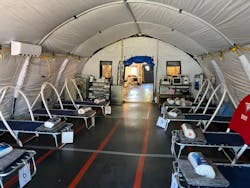The solar microgrid now powering a COVID-19 clinic for a camp of about 3,000 asylum seekers in Mexico began with an Instagram post.
In April, Will Heegaard, director at Footprint Project, which focuses on providing clean energy in disaster areas, was keeping on eye on Instagram posts in high-risk areas.
He saw a post by Global Response Management (GRM), a non-governmental organization that provides emergency medical care and humanitarian relief, about its work in mid-April setting up a COVID-19 clinic in Matamoros, Mexico for asylum seekers.
He asked if the clinic was interested in clean energy for the effort.
The answer was yes.
Heegaard and his associates drove to the camp in about a day with a containerized mobile and energy storage trailer, arriving after delays at the border. “It took longer to go through customs and ensure paperwork was correct to move a solar ICU across the border,” he says.
GRM had already set up a 20-bed traditional field hospital, and had purchased a 20-kW fossil fuel generator, which hadn’t made it to Mexico before GRM began its work.
One small win for asylum seekers
Once Heegaard and his associates made it across the border, they arrived at the camp on April 25. Within a day and a half, a microgrid powering the medical operation was up and running, says Heegaard.
The system now serves as the primary energy source for the ICU, a pop-up clinic deployed by GRM. It has 20 beds and diagnostic and treatment ready medical equipment. The microgrid system includes 11 kWh of batteries in the trailer and a 4-kWh battery bank in the medical ICU. The solar system includes 2.4 kW of PV in the trailer and the pop-up tent has 1.8 kW of PV.
The trailer is a six-by-twelve foot aluminum frame cargo trailer, with batteries, inverters and charge controls inside. It also has extra space for storing tools and maintenance equipment.
“If we can be as green as reasonably possible, that is one small win for a group of people that have endured a lifetime’s worth of losses” — Blake Davis
The camp rarely needs to operate the backup fossil-fuel generator, saving about $50 a day, says Heegaard.
The solar tent that houses the microgrid is located next to the medical tent, and in addition to powering the medical tent, provides a space for healthcare workers to clean up and sanitize after they’ve been working in the ICU.
Supporters jumped at the opportunity to help pay for the project. The initial deployment was funded in about a day and a half with about $5,000 from an ongoing crowdfunding project on Facebook.
Supplying solar energy and batteries to a camp littered with garbage and too few toilets on a site beside the dirty Rio Grande River provided a much-needed breath of fresh air.
“If we can be as green as reasonably possible, that is one small win for a group of people that have endured a lifetime’s worth of losses,” says Blake Davis, a paramedic who is director of operations for GRM. “The people stuck in this camp need to live in horrible conditions while awaiting a chance at a better life in the US. Reducing the diesel exhaust particulates they are inhaling is one less health risk they need to worry about.”
Calming effect of quiet
Up to 20,000 pounds of carbon dioxide per month are offset by the solar microgrid, says Catherine Von Burg, president & CEO of SimpliPhi Power, which provided the batteries and engineering and design services to help Footprint Project optimize the use of the solar system.
Studies have shown that air pollution increases risks to COVID-19 patients.
Not only are patients exposed to cleaner air as a result of the project; most of the time, they don’t have to listen to the noise of a generator, says Davis.
“There is a calming effect when we are running off of solar, the AC is on, and we are able to work in peace.”
Right now, the COVID clinic has no COVID patients. But that’s expected to change. Once the clinic has patients, it will be important for patients to rest and focus all their energy on beating the virus, he says.
“Being able to have peace and quiet will be key to mitigating the stress of working, or being a patient, in a COVID field hospital.”
Covid clinic, solar tent and trailer. Courtesy of Will Heegaard, Footprint Project
Energy efficiency first
Once Heegaard and his associates arrived at the camp, their first task was to identify how to make the camp more energy efficient. They learned that the only load they couldn’t power with their clean energy was the heating, ventilating and air conditioning system (HVAC), which is a “huge power hog.”
The Footprint Project team added mini split heat pumps to help cool the clinic and lower the amount of time the main HVAC system would be required.
“Half the battle is efficiency. If you increase the efficiency of the system, you don’t need such a big power system,” Heegard says.
Three days into the project, Heegaard and associates were testing the microgrid, including the fossil fuel generator, and the generator bar wired to the HVAC started to melt.
“It’s a big challenge, we see this a lot, aid organizations spend $5,000 to $10,000 on a generator, run it full stop and spend money on fuel, and then the generator breaks.. They are not meant to run 24-7. Usually our systems become the only backup,” he says.
With the microgrid providing most of the power, the need for the generator dropped, cutting costs. Fuel costs can be a significant strain on these types of operations, Heegard notes. “If you can reduce that or take it out of the equation, money can be spent on services and programs with lasting benefits.”
Future of humanitarian: the solar microgrid
Lowered fuel costs are not the only big benefit. The availability of a treatment center in a dirty, crowded camp — where five people sleep per tent — is important during a pandemic.
“It’s a huge weight off of a lot of people’s shoulders knowing there is a safe place to isolate and stay,” says Heegaard.
The battery system from SimpliPhi Power provided added advantages. The SimpliPhi Power system uses lithium ion batteries that don’t include cobalt. That means they’re non toxic and aren’t susceptible to thermal runaway. And they can be fully charged within the four to five hour window of sunshine, says Von Burg.
While the solar microgrid was Footprint Project’s first COVID-19 project, it likely won’t be the last.
“As we witness all the supply and domino effects of COVID, economically and socially, it can be powerful to have examples of projects that show the future of what humanitarian aid can be,” says Heegaard.
Join us June 1 for a special session, “Healthcare & Microgrids: Ensuring Power When the Value of Resiliency is Immeasurable” at the free Microgrid Knowledge Virtual Conference.








